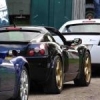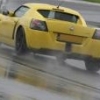
Diy Geo
#1

Posted 18 January 2017 - 10:10 PM
#2

Posted 18 January 2017 - 10:31 PM
I too also pondered this during my many hours of geoing.
The solution I came up with is:
1. Under the chassis front measure accurately from side to side and then secure a nail/screw/other to the centre point.
2. Under the chassis rear do the same.
3. Now buy/find something really long and straight (like a 5m aluminium I-beam). Offer an edge of the rail up to the 2 centre line points under the car, such that the rail sticks out of the front and rear of the car.
4. Now using this central datum line, align your 2 side strings in parallel and equidistant to the rail edge. Use the extreme ends of the I-beam to minimise any error.
Bingo. Now your 2 strings are running parallel with the centre line of the car. All 4 wheels can now be accurately aligned to the strings. ![]()
Tip: The longer your I-beam, the smaller any error will be. Also ensure you datum your garage floor, I was shocked by how much my seemingly flat garage floor was out by, and I built varying height plinths for my 4 wheels to all sit at the same height.
Bear in mind that I simply devised this method off the top of my head, I'm not sure what the professionals do - probably ignore the matter and let the car crab!
GL.
Edited by Nev, 18 January 2017 - 10:54 PM.
#3

Posted 18 January 2017 - 10:38 PM
#4

Posted 18 January 2017 - 10:44 PM
Thanks for the feedback and ratifying my logic.
For accuracy I do the geo once, then I drive the car out and do it again with the car facing the other way. I found it really surprising accurate (much to my amazement).
All it takes is care and patience and some simple o-level trig (which probably rules out 50% of the owner on here!). Also, I think you have the massive advantage of setting the car up exactly as you like. I must have made upwards of 100 or 150 geo changes to my car setup over the last 5 years, in order to home in how I want it. No professional geo would ever offer you that (unless you paid them £1000s).
Edited by Nev, 18 January 2017 - 10:55 PM.
#5

Posted 18 January 2017 - 10:58 PM
Wow you must have put some hours in. Have you ever considered increasing the length of the line of the wheel with some sort of straightedge fastened against it. Basically I was thinking this would increase the measurements and decrease the margin of error when calculating your anglesThanks for the feedback. For accuracy I do the geo once. Then I drive the car out and do it again with the car facing the other way. I found I had really surprising accuracy (much to my amazement). All it takes is care and patience and some simple o-level maths (which probably rules out 50% of the owner on here!). Also, I think you have the massive advantage of setting the car up exactly as you like. I must have made upwards of 100 or 150 geo changes to my car setup over the last 5 years, in order to home in how I want it. No professional geo would ever offer you that (unless you paid them £1000s).
#6

Posted 18 January 2017 - 11:03 PM
Wow you must have put some hours in. Have you ever considered increasing the length of the line of the wheel with some sort of straightedge fastened against it. Basically I was thinking this would increase the measurements and decrease the margin of error when calculating your anglesThanks for the feedback. For accuracy I do the geo once. Then I drive the car out and do it again with the car facing the other way. I found I had really surprising accuracy (much to my amazement). All it takes is care and patience and some simple o-level maths (which probably rules out 50% of the owner on here!). Also, I think you have the massive advantage of setting the car up exactly as you like. I must have made upwards of 100 or 150 geo changes to my car setup over the last 5 years, in order to home in how I want it. No professional geo would ever offer you that (unless you paid them £1000s).
Yes, you are spot on with that suggestion, and I did exactly that with long edges of MDF.
My home made camber gauge is a wooden affair that must have a straight edge of about 2 metres (to also reduce error margins).
I also have a professional toe in/out gauge that I double check my string measurements with too. You can pick them up from bankrupt garages sales (eBay) very cheaply sometimes.
Edited by Nev, 18 January 2017 - 11:04 PM.
#7

Posted 18 January 2017 - 11:11 PM
#8

Posted 18 January 2017 - 11:18 PM
Over the years doing my own geoing and spannering I have come up with a few conclusions which don't seem to concur with the info on the internet. You (and some of the less sycophantic masses) might be interested in them:
1. Adding floating mass to the front wheels had a dramatic improvement to handling. I discovered this when I added about 4 Kg per front corner when installing my own brake setup. It really does help (contrary to popular opinion).
2. I found toe out on the front worry-some at speed when going in straight(ish) lines. Toe-out might be fine on a flat track where you are almost always turning to some extent and going at relatively slow/mid speeds. But at high speeds with varying cambers when trying to go fast I found it very twitchy, so after experimenting with front toe-out for a few months I dialled it out.
3. I find soft (OEM) spring settings best for the B-roads I drive on. I have tried about 5 different spring rates at both the front and rear, and found 275f, 375r the best.
4. Obviously be very wary of changing wishbone angles from OEM. This is fundamental, but I am sure you already know it.
5. I am not keen on masses of camber which some people seem to be. Bear in mind I am a road driver though, and I don't corner at 99.99% of the CoF. I currently have -0.7 front camber, and -1.7 degrees rear camber. I am currently even thinking of reducing this by a smidge (both front and rears).
6. I have studied 1 other persons bump steer curves and indeed made my own using a laser strapped to the hubs (pointing at the garage door) and moving the hubs up and down by hand and taking measurements. This gives a fairly straightish (arithmetically incremental) bump curve (when under bump/compression). However, in practice I "feel" that the car seems to react in a different (more acute logarithmic) way than the curves suggest. I have no idea why this is, as the theory seems to conflict with the driving experience. Anyway, this is why I am very keen on not lowering the car, as the effects have rapidly increasing bad effects IMO.
Edited by Nev, 18 January 2017 - 11:35 PM.
#9

Posted 19 January 2017 - 01:04 AM
#10

Posted 19 January 2017 - 07:07 AM
Was going to add this to the current basic geo post but thought id start a new one Basically it's a question regarding diy geo using string. I added to a post on seloc regarding this and it was discussed but it's still really bugging me. I understand that the diy method to set wheel toe is to set 2 lines (string) to run parallel to the centre line of the vehicle and use these to measure to the wheel. I understand that the lines are often set equal distance apart by using poles of equal length at either end My question is around how the lines are set so they run parallel with the car centre line. The general method seems to be to set them against the centre of the wheels. My concern is around the fact that the rear uprights do not actually pivot around the centre of the wheel . I Just cannot understand how this method can be accurate especially when the measurements being made are fairly small anyway. Just wondering if anyone could advise on this
In reality it's not that much of an issue. The first thing is to ensure that the lines run parallel. That's done with equal length poles. What I did is to make a rig for the back to fit the pole on, using the undertray bolts. On the front the pole fits right across the radiator opening. Next step is to measure the distance from the lines to the center of the wheels and ensure that's equal both sides. That done, the angles should be straight(ish). Good enough for government work. Now you can start measuring the toe and adjust. With that done, you measure the distances to the centers of the wheels again. If not OK, you adjust. I always go through it this way, but hardly ever adjust. That's because the toe is usually not that much off. With toe and using strings, it's possible to measure to about 0.25 mm accuracy.
#11

Posted 19 January 2017 - 07:21 AM
#12

Posted 19 January 2017 - 07:48 AM
Unsprung weight is good 😊 You heard it here first!
I do accept this info flies in the face of what one reads generically on the internet (which is based on good basic principles), but try it first and then tell me you don't think it helped. It is sometimes the case that theory and practice vary in science/engineering etc.
To take an example, something like an Audi RS6 which has a hugely heavy engine that sticks out in front of the front wheels would (in theory) be an aweful handling car. Yet for some reason(s) everyone who drives on thinks it is an awesome car to drive and I expect it is a very rapid car even on a twisty road, most probably out pacing a lot VX220s.
In the same way, something like a Porche xxx with fat 20"+ wheels and heavy brakes and heavy discs and heavy tyres has a very heavy floating mass at the front. But you don't hear people say "Ooh my Porche is a crap handing car, please take it back because it won't steer down a B-road". In fact most Porschs are meant to be great handling cars, despite the heavy floating mass.
Anyway the difference on my (admittedly unusually wheeled car) was really marked after my heavier brakes were installed. Perhaps the increased centrifugal force of the discs is something to do with it, I'm not sure. Either way, in my case I was quite surprised (in a good way) by the change, when I was (like you) I was expecting the handling to be worse/dulled.
And lastly, I don't get many passengers who step out of Nipper without commenting on the steering. You can read the comments from the last guy (who when went on to buy a VX220) on my thread:
Edited by Nev, 19 January 2017 - 08:17 AM.
#13

Posted 19 January 2017 - 09:55 AM
Nev, if you have the time and/or inclination it would be really useful if you could take some photos of the various stages and do a bit of a guide when you do your next geo.
#14

Posted 19 January 2017 - 02:49 PM
Nev, if you have the time and/or inclination it would be really useful if you could take some photos of the various stages and do a bit of a guide when you do your next geo.
Hmm, would anyone actually use it? I get the feeling most people prefer to just hand their car over with a fist full of dollars.
There's loads of info on the web about how to do the basic stuff, anyone with the ability to turn a spanner and do basic trig can read up on it already. It's how I did it TBF.
Edited by Nev, 19 January 2017 - 02:51 PM.
#15

Posted 19 January 2017 - 03:02 PM
I know it is an arse and it is readily available on line but following a good guide really does make a job that little but easier and gives you the confidence to have a go.Hmm, would anyone actually use it? I get the feeling most people prefer to just hand their car over with a fist full of dollars. There's loads of info on the web about how to do the basic stuff, anyone with the ability to turn a spanner and do basic trig can read up on it already. It's how I did it TBF.Nev, if you have the time and/or inclination it would be really useful if you could take some photos of the various stages and do a bit of a guide when you do your next geo.
Edited by Tibbles Stryker, 19 January 2017 - 03:03 PM.
#16

Posted 19 January 2017 - 03:15 PM
I know it is an arse and it is readily available on line but following a good guide really does make a job that little but easier and gives you the confidence to have a go.
Hmm, would anyone actually use it? I get the feeling most people prefer to just hand their car over with a fist full of dollars. There's loads of info on the web about how to do the basic stuff, anyone with the ability to turn a spanner and do basic trig can read up on it already. It's how I did it TBF.Nev, if you have the time and/or inclination it would be really useful if you could take some photos of the various stages and do a bit of a guide when you do your next geo.
Nev - Also as we have said most of the guides use the center of the rear hub to set the parallel lines !!!!!!
#17

Posted 19 January 2017 - 04:29 PM
Nev, if you have the time and/or inclination it would be really useful if you could take some photos of the various stages and do a bit of a guide when you do your next geo.
Hmm, would anyone actually use it? I get the feeling most people prefer to just hand their car over with a fist full of dollars.
There's loads of info on the web about how to do the basic stuff, anyone with the ability to turn a spanner and do basic trig can read up on it already. It's how I did it TBF.
Requires a lot of effort to find all the info and learn how to do it. A VX220 specific idiot's guide with loads of pics would be great for me.
#19

Posted 19 January 2017 - 08:35 PM
#20

Posted 19 January 2017 - 08:39 PM
0 user(s) are reading this topic
0 members, 0 guests, 0 anonymous users





















